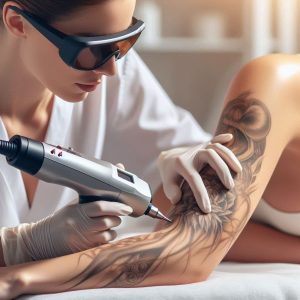How Biology and Medicine Work Together to Clear Your Skin
 When you get a tattoo, the ink is placed deep in the dermis, the second layer of your skin. This layer is more stable than the outer layer, which sheds over time. Once the ink enters the dermis, your immune system reacts. White blood cells called macrophages try to “eat” the ink particles, but they can’t break them down completely because the pigment molecules are too large. Some of these cells trap the ink, keeping it in place, while others move small amounts of pigment away over time.
When you get a tattoo, the ink is placed deep in the dermis, the second layer of your skin. This layer is more stable than the outer layer, which sheds over time. Once the ink enters the dermis, your immune system reacts. White blood cells called macrophages try to “eat” the ink particles, but they can’t break them down completely because the pigment molecules are too large. Some of these cells trap the ink, keeping it in place, while others move small amounts of pigment away over time.
This biological process is what makes tattoos permanent. To remove the ink safely, we must use medical technology that works with, not against, your body’s natural healing process. That’s where experienced tattoo removal clinic Gold Coast comes in.
The Role of Lasers in Tattoo Removal
Modern tattoo removal clinics rely on laser systems that use short bursts of energy to break up the ink. The most common technologies include Q-switched and picosecond lasers. These lasers target the pigment without harming the surrounding skin. Each burst of light energy heats and shatters the ink particles into smaller fragments that your immune system can finally remove.
Different ink colors respond to different wavelengths. For instance, black and dark blue absorb most laser wavelengths and are the easiest to remove. Green, red, and yellow inks require more specialized lasers. This precision helps minimize scarring and speeds up recovery.
From a biological point of view, the body’s lymphatic system plays a key role after treatment. Once the ink particles are broken down, they travel through the lymphatic pathways and are naturally eliminated. This is why multiple sessions are needed because the body needs time to flush out the pigment after each treatment.
Why Experience Matters in Tattoo Removal
Tattoo removal is both a medical and an artistic process. An experienced clinic understands how to balance safety, comfort, and results. Skilled professionals know how to adjust the laser’s intensity based on your skin type, ink color, and tattoo age. They also recognize early signs of irritation and use cooling systems or numbing gels to make the experience more comfortable.
Clinics with medical supervision, such as those with dermatologists or trained laser technicians, can prevent common issues like blistering or hyperpigmentation. They can also advise patients on aftercare to promote proper healing. For example, keeping the treated area clean, avoiding direct sunlight, and applying gentle moisturizers help the skin recover faster.
An experienced team can also guide you on realistic expectations. Complete removal may take 6–10 sessions depending on the tattoo’s complexity. Some older or professional tattoos use dense pigments that require longer treatment plans. A trusted clinic will create a customized treatment schedule and provide clear information about what to expect in terms of results and healing.
Healing and Aftercare: Supporting the Body’s Recovery
After each session, your skin will need time to recover. Mild redness, swelling, or scabbing is normal. These signs show that your body is responding to the treatment and processing the pigment. It’s important not to pick or scratch the treated area to avoid scarring. Gentle cleaning with mild soap and cool water helps keep the area free from infection.
The immune system continues working behind the scenes even after visible healing. It removes broken-down ink particles for weeks following each session. Staying hydrated and maintaining a balanced diet can help support this process. Good circulation also helps, so regular light exercise may contribute to faster pigment clearance.
From a medical point of view, your skin’s healing ability depends on your overall health and lifestyle habits. Smoking, poor nutrition, or sun exposure can slow down recovery. On the other hand, proper rest, hydration, and sun protection can improve your results significantly.
The Connection Between Biology, Medicine, and Art
Tattoo removal combines the science of biology, the precision of medical technology, and the skill of experienced professionals. Understanding how the skin and immune system respond helps patients make informed decisions. Each treatment is a collaboration between modern medicine and your body’s natural healing ability.
An experienced tattoo removal clinic doesn’t just focus on fading ink, it prioritizes your skin health. By aligning laser settings with biological responses, experts can remove tattoos safely and effectively while maintaining your skin’s natural texture and tone.
In short, tattoo removal is not just about technology. It’s about understanding how your body works, using medicine wisely, and trusting professionals who know how to bring both together. With proper care, the results can be clean, smooth, and satisfying.